Reserve Bank of Australia Annual Report – 1984 Economic Developments[*]
The International Economy
During 1983/84 industrial countries emerged more clearly from their severe recession, although recovery was not evenly shared. In the United States, growth in real gross domestic product (GDP) was at its strongest for over a decade; the improvement was also solid in Japan, Canada, the United Kingdom and West Germany. Elsewhere in Europe, however, economic activity was more subdued. For the most part, the impetus to recovery came initially from private consumption but growth has become more broadly-based; in the United States and West Germany, in particular, a marked revival in business fixed investment added support. External demand gave an important early boost to growth of the Japanese economy but domestic demand also contributed strongly over recent quarters.
The resumption of growth was not mirrored in labour markets, except in the United States where unemployment rates dropped sharply. Overall, unemployment remained a serious concern. Near the end of 1983/84, unemployment in the OECD area was about 8.3 per cent, not much below its level of 8.9 per cent twelve months earlier.
An encouraging feature of the recovery was its conjunction with fairly stable and low rates of inflation. This reflected continued moderation in wages growth and some improvement in labour productivity, in a climate of restraint applied by monetary policy. The general stability of oil prices also contributed. In the year to June 1984, consumer prices in the OECD area grew by about 5½ per cent. This was only a little above the figure for the previous twelve months, when price performance was at its best since the early 1970s. Japan and West Germany had inflation rates below 3 per cent, the United States around 4 per cent.
The aggregate current account deficit of OECD countries increased in 1983/84; as well, the distribution of current account positions changed sharply. Because of its lead in the economic recovery and the strength of the U.S. dollar in international markets, the deficit for the United States widened considerably. This was matched, in part, by improved balances in other industrial countries, particularly Japan. Subdued oil revenues kept the aggregate current account of the oil-exporting countries in deficit. For the non-oil developing countries, efforts to curb import demand led to a sharp fall in their combined current account deficit.
7 International Economic Conditions
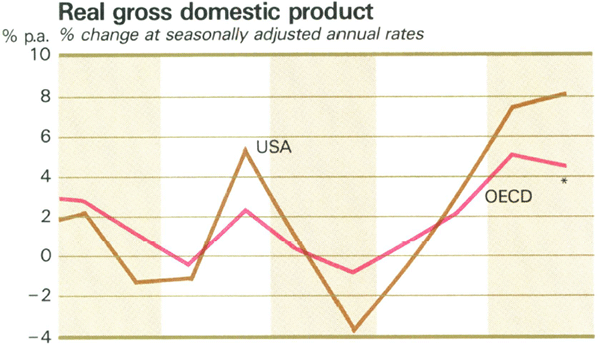
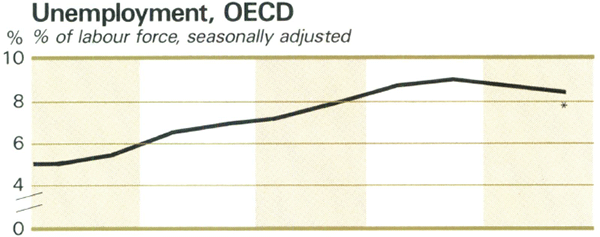
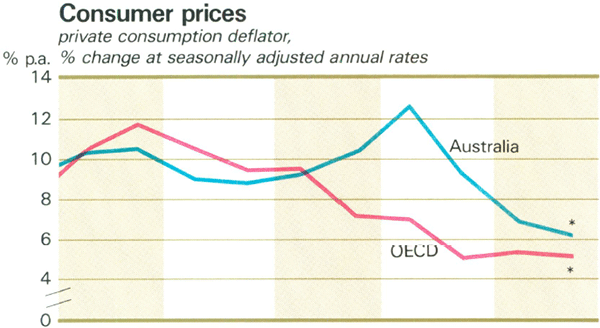
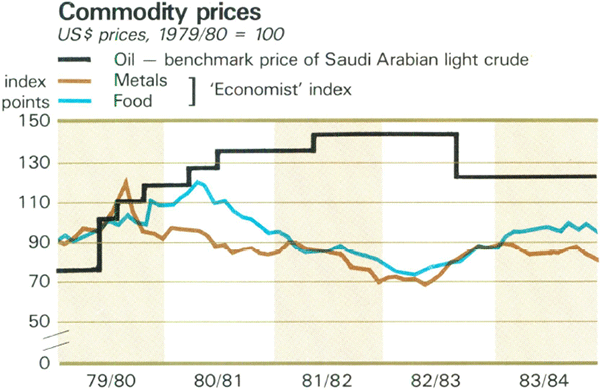
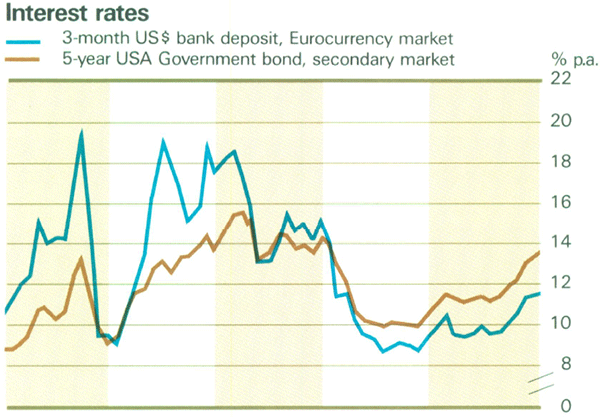
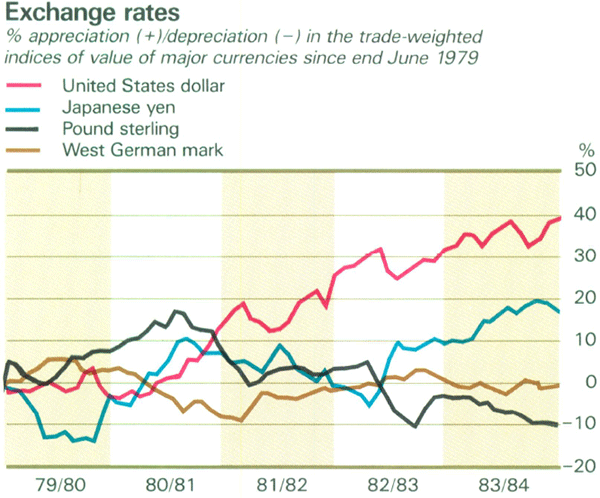
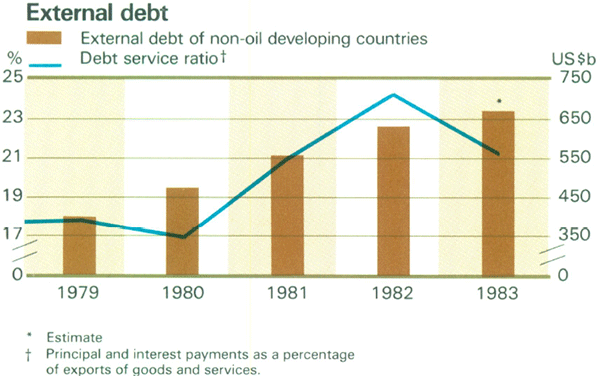
As imports of industrial countries expanded with the recovery, the volume of world trade picked up. However, prices of internationally-traded goods did not sustain the earlier improvement from their trough around the end of 1982. Agricultural commodity prices continued to rise strongly but metals prices lost ground. Substantial increases in zinc prices were offset by weakening copper prices and a levelling off in prices for aluminium, which had outperformed other metals in the early stages of recovery. Over the year to June 1984, the “Economist” index of non-oil commodity prices, in U.S. dollars, rose by only around one per cent.
Interest rates lost their downward momentum in 1983/84. In the United States, short-term rates reached an early peak and then declined for several months; they then moved steadily upwards to their highest levels in two years. Long-term rates of interest also rose strongly. Elsewhere, short-term and long-term interest rates showed little net movement over the year.
In view of the concurrent steadiness in inflation, these developments left real interest rates relatively high in most countries. In part, this reflected the reluctance of monetary authorities to relax monetary discipline – and jeopardise hard-won gains on inflation – during the recovery phase, despite pressures from large budget deficits in some cases. In the major countries, growth in monetary aggregates was generally held within announced target ranges over 1983/84. Another element was market concern that monetary authorities might be unable to stay their course if growing private demands on capital markets were to clash with unrestrained public borrowing needs. Concerns about these policy tensions were a key factor behind the rise in U.S. interest rates in the latter part of 1983/84.
With interest rate differentials generally in its favour and global political tensions sometimes high, the U.S. dollar continued to strengthen on foreign exchange markets over most of 1983/84. On occasion, this prompted other countries to undertake relatively large intervention in support of their currencies. By early January 1984, the U.S. dollar had reached its highest level in a decade against major European currencies and on a trade-weighted basis. For a brief period thereafter, it weakened sharply as markets came to focus on the size of the U.S. current account deficit but by year end, with U.S. interest rates still increasing, the U.S. dollar had reached and in some cases surpassed its early-January levels. Over the year as a whole, the U.S. dollar strengthened against all major currencies except the yen.
International financial markets continued to be concerned with the external payments difficulties of developing countries, and the pressures these were exerting on international banks. Markets took encouragement from early positive results under some large-scale support programmes which the International Monetary Fund (IMF) had arranged for major debtor countries. As part of these programmes, commercial banks continued to lend to debtor countries through 1983/84, albeit at a much reduced rate. They also agreed to further substantial rescheduling of commercial bank debt, which provided temporary relief from debt servicing burdens. For their part, the adjustment efforts of debtor countries contributed to a more manageable current account outcome, with prospects of further improvement as exports responded to the more buoyant external environment.
These developments appeared to produce a more tractable external debt position for the developing countries as a group. Nevertheless, the difficulties of some major borrowers in Latin America highlighted the important areas of vulnerability which remained. These concerns moved closer to Australia when the Philippines encountered severe external payments difficulties, beginning in the latter part of 1983.
During 1983/84, member governments approved a substantial increase in resources for the IMF, through quota subscriptions and the General Arrangements to Borrow. The IMF also arranged an interim financing facility through the Bank for International Settlements (BIS). Under this facility funds will be provided to the IMF by the BIS against the guarantee of central banks of 17 industrial countries. The Reserve Bank is a participant. The IMF simultaneously concluded borrowing arrangements with the Saudi Arabian Monetary Agency, Japan and the National Bank of Belgium.
Central banks and supervisory authorities continued to seek more effective supervision over the foreign and domestic operations of commercial banks. Authorities in some major industrial countries introduced requirements for more detailed disclosure of their banks' external commitments, especially to heavily-indebted countries. In the United States, the financial authorities provided backing to one large bank facing a substantial run on deposits; this backing was additional to a support facility from other U.S. banks.
The Australian Economy
Production and spending
The Australian economy also participated, strongly, in the general upturn in economic activity in 1983/84. The resurgence was emphatic in the September quarter and was sustained over the year. In addition to the improvement in international economic conditions, the main sources of growth were recovery in the rural sector, an uplift in most major items of domestic final spending and a reversal of the stock cycle.
Gross national expenditure, in real terms, increased by over 6 per cent after its pronounced fall in 1982/83. In contrast to the previous year, the external sector provided only a small additional stimulus to domestic production. Export growth was up sharply but this was largely offset by the rise in import volumes as the recovery proceeded. The outcome for 1983/84 as a whole was an increase in real GDP of around 7 per cent, the best growth performance since 1968/69. Farm product responded strongly to the breaking of the drought while non-farm production enjoyed a broadly-based increase of around 5½ per cent. This included a modest recovery in the manufacturing sector although activity there has yet to reach levels prevailing before the recession.
8 Production and Spending
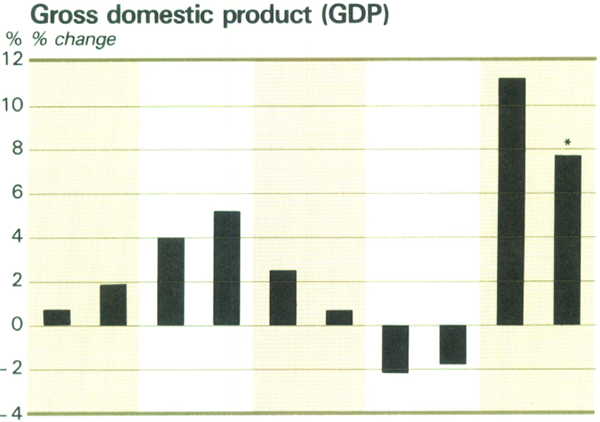
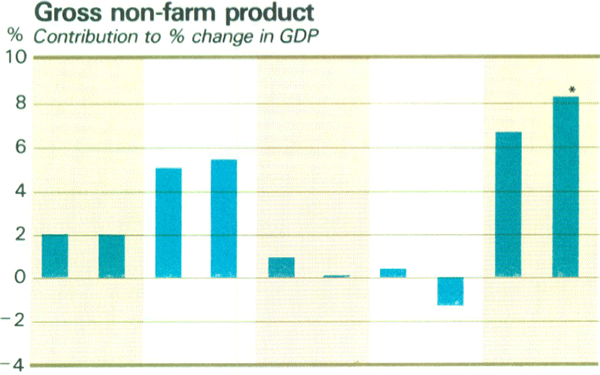
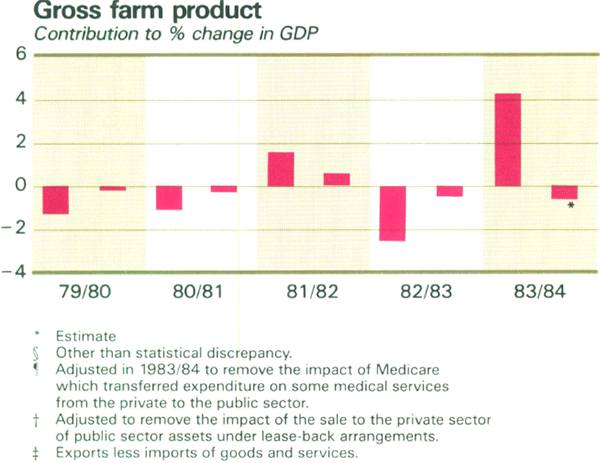
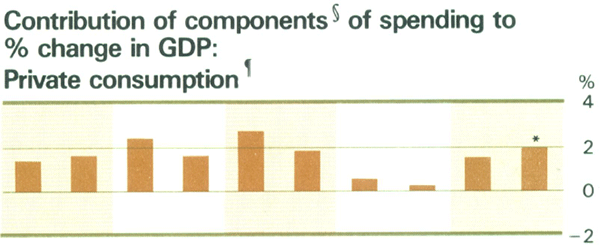

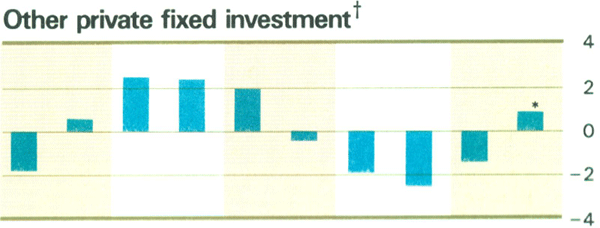

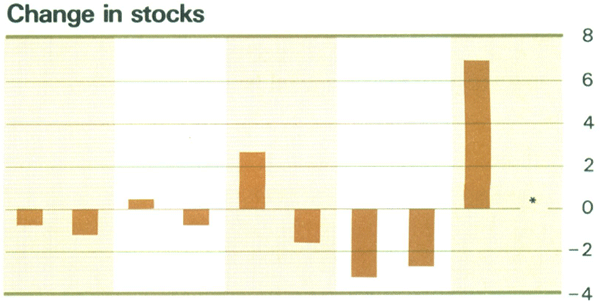
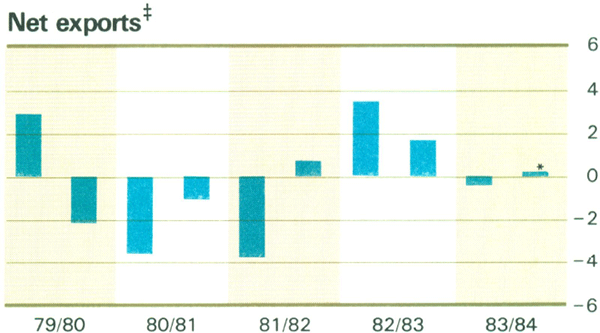
The public sector provided strong impetus to domestic final spending in 1983/84. In real terms, public spending rose by over 4 per cent (excluding the effects of sale/lease-back arrangements and of Medicare), almost double the increase in the previous year. The component growing most quickly was capital expenditure, by both Commonwealth and state and local authorities.
Private dwelling investment also increased substantially in 1983/84. Ready availability of finance, lower interest rates and assistance to first-home buyers from the Commonwealth Government were the spur. However, this expenditure was still well below its peak level in 1980/81.
Private consumption, which had been relatively flat in the previous year, resumed moderate growth. Underpinning this was expansion in real household disposable income and an apparent revival in consumer confidence. The household saving ratio (adjusted for a sharp jump in farm incomes) increased, although by a much smaller amount than in the previous two years.
The weakest component of domestic spending was business fixed investment. Its fall of around 10 per cent followed a substantial drop in 1982/83. Investment in non-dwelling construction was especially subdued after completion of some major projects in the mining sector. However, business fixed investment began to pick up in the second half of the year, the first positive response since the last quarter of 1981.
Movements in stocks made an important contribution to the rebound in domestic production. After an unprecedented decline in the previous year, the rundown of stocks held by business continued – albeit more slowly – in the first half of 1983/84 and the ratio of stocks to sales fell to its lowest recorded level. Some de-stocking may have been involuntary in light of the unexpectedly strong recovery in activity. From that point, however, stocks held by businesses began to build up as sales volumes continued to grow Even so, the ratio of stocks to sales remained at a very low level. Stocks of rural products, especially wheat, increased sharply following very favourable growing conditions.
Prices and incomes
There was a marked easing in inflation during 1983/84. Crucial to this was the general containment of wage pressures, for which the wages pause in the second half of 1982/83 and the Prices and Incomes Accord were central elements. Slower growth of import prices – due in part to the appreciation of the Australian dollar over much of the year – also contributed. Inflation, nonetheless, remains above that in our major trading partners but the differential has narrowed.
The consumer price index increased by 3.9 per cent over the course of 1983/84, compared with an increase of 11.2 per cent the previous year. Part of this improvement was a once-for-all decline in the index associated with introduction of the Medicare scheme on 1 February 1984. Excluding the impact of Medicare, consumer prices increased by 6.5 per cent during the year, the smallest yearly increase since 1971/72. Other measures confirm the moderating of inflationary pressures. The private consumption deflator increased by about 6 per cent during the year, well below the rise of 10.7 per cent the year before.
Award wages grew by about 8.5 per cent over the course of 1983/84. This was higher than during 1982/83 when the wages pause resulted in very limited growth in awards in the second half of that year, but much lower than the very sharp wage increases during the so-called resources boom. Wages growth in 1983/84 derived mainly from two national wage increases of 4.3 per cent in September and 4.1 per cent in April, based on the principle of full six-monthly indexation. These increases were awarded by the Arbitration Commission conditional upon unions giving an undertaking to make no extra claims other than within the wage-fixing principles; compliance with this appears to have been almost complete. Earnings grew more quickly than award wages during the year, due in part to increases in overtime hours worked.
9 Prices, Incomes and The Labour Market
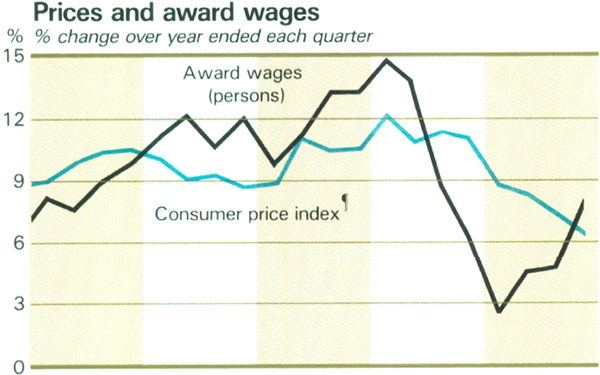
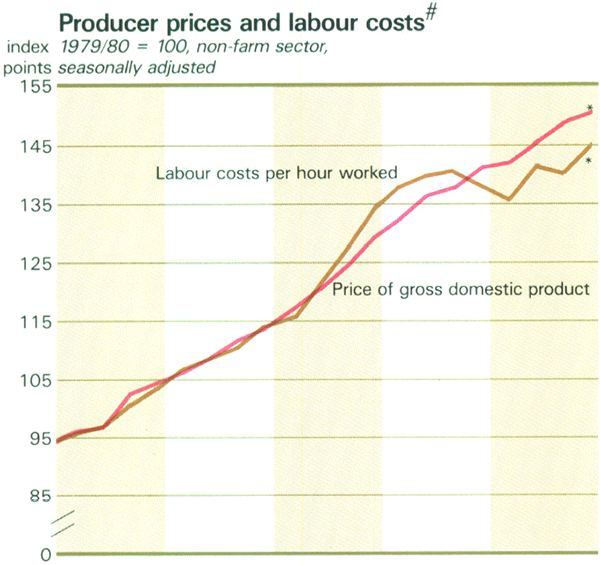
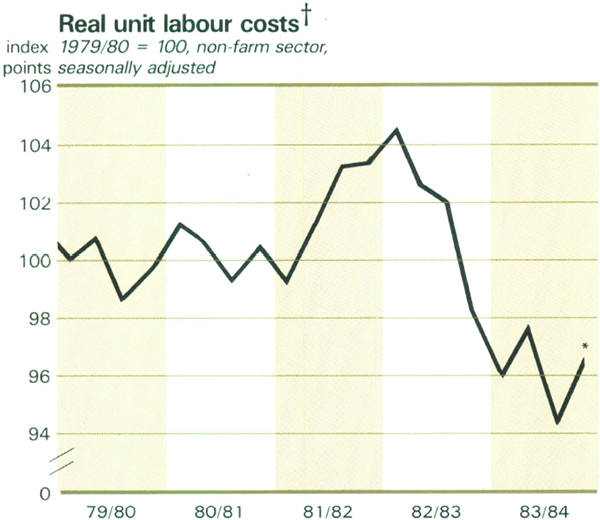
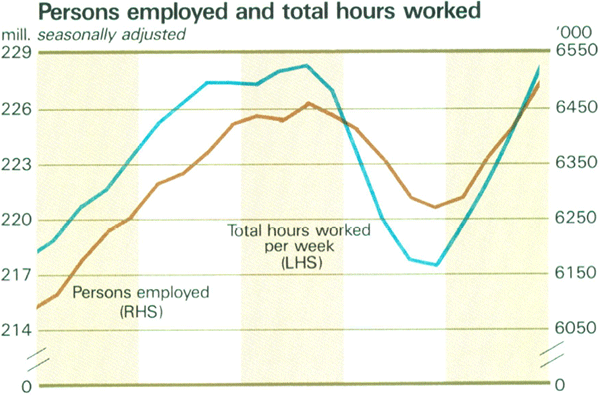

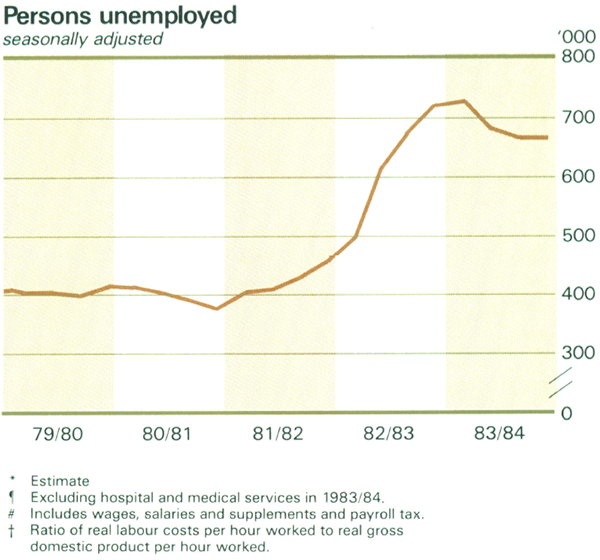
Labour costs reflected the containment of wage pressures and gains in productivity during the recovery. Unit labour costs fell in the early part of 1983/84 and then resumed an upward path; on average, however, they were little above their level in 1982/83. With producer prices rising more quickly than these costs, unit labour costs in real terms were at their lowest for over a decade.
The reduction in costs and firmer demand gave an important boost to profitability, which had slumped to close to an historically low point. Towards the end of the year the proportion of national income accruing as gross operating surplus of trading companies had risen to levels of the early 1970s.
The labour market
The labour market responded quickly to the rebound in economic activity and the sharp improvement in profitability in 1983/84. Aspects of this response, however, were unusual when compared with previous swings in economic activity.
Employment rose by 3.7 per cent, or about 233,000 people, in a fairly steady course in the year to June 1984. The increase was evenly shared between females and males (in the latter case, almost all working full-time). Total hours worked rose more sharply, by around 5 per cent. Underlying this was a strong increase in full-time employment and greater resort to overtime, as activity gathered pace. The recovery in labour usage appeared stronger and more swift than in previous upturns in activity. In 1982/83, the decline in employment had been concentrated in the manufacturing and construction sectors, in which male full-time employees are heavily represented. With the outlook then bleak, employers responded by shedding labour rather than hoarding it as in some earlier downturns. As prospects brightened and wages growth moderated, employers in construction moved to restore their workforces to more normal levels and manufacturing employment ceased falling. Added to this was continued strong growth of employment in the tertiary sector during the year.
The participation rate had no clear trend during most of 1983/84, but showed signs of an increase in the final months. Atypically, the participation rate has not seemed very sensitive to labour market conditions in most recent years. The heavy incidence of unemployment among adult males, who traditionally have been constantly in the workforce, whether or not in employment, may partly account for this. The labour force grew by about 2.5 per cent during the year, slightly above increases in the two previous years.
The sharp recovery in employment allowed a fell in unemployment from its post-war record the previous year. After little change for some months, the unemployment rate fell from 10.4 per cent (seasonally adjusted) in September 1983 to 9.3 per cent in June 1984. Over the year the number of people unemployed declined by about 59,000 to 634,000 (not seasonally adjusted). The decline was greatest for adult males seeking full-time work; other groups also gained but unemployment rates, particularly for young people, remained high. People unemployed for more than twelve months increased in numbers, and as a share of total unemployment.
The balance of payments
Australia's balance of payments, as measured by net official monetary movements, was in overall surplus of $1,850 million in 1983/84. A $6,697 million deficit on current account was more than covered by net capital inflow of $8,547 million. The main aggregates are shown in Graph 10.
The current account outcome was shaped by several factors. The important backdrop was the recovery in the international economy, which provided the basis for strong export growth. The breaking of the drought and the greater competitiveness of local industry to mid 1983 also played a part. This competitive edge was subsequently eroded as unit labour costs began to rise and the Australian dollar continued to strengthen, on a trade-weighted basis, until the final months of 1983/84. Other offsetting factors were the build-up of import demand as the domestic economy expanded, and the substantial costs of servicing the large capital inflows in this and other recent years.
10 Balance of Payments
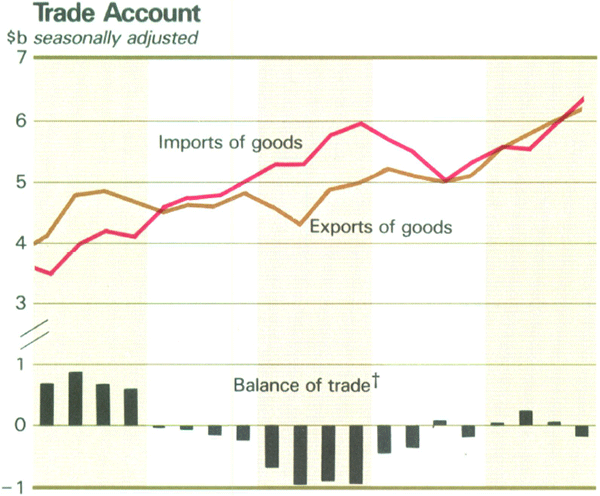
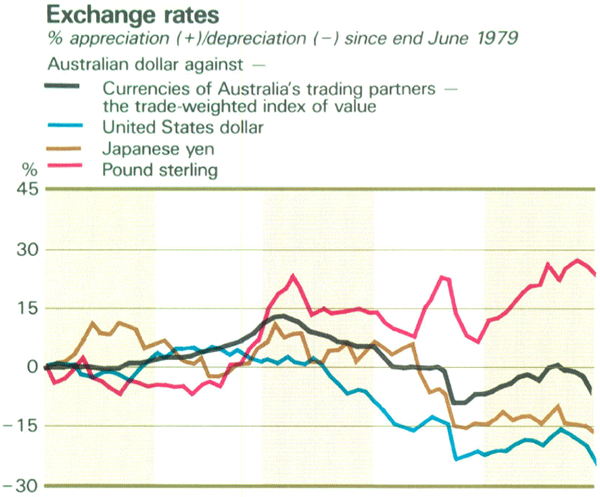
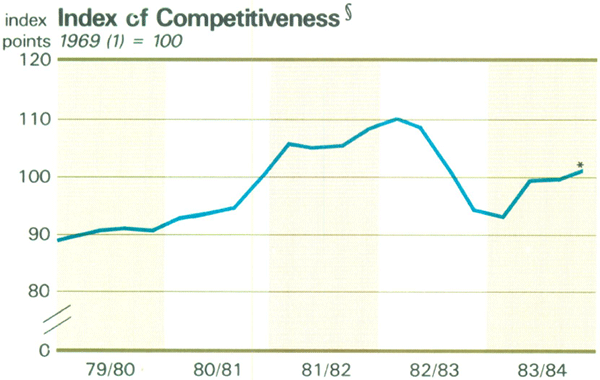
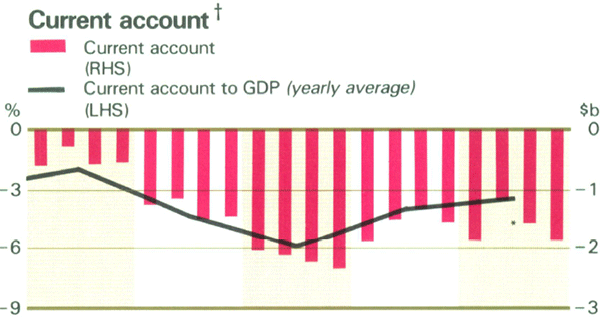
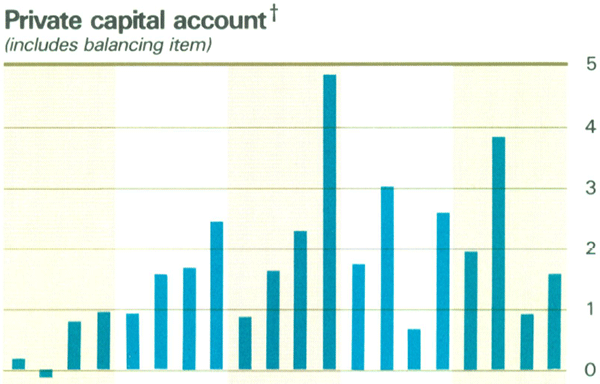

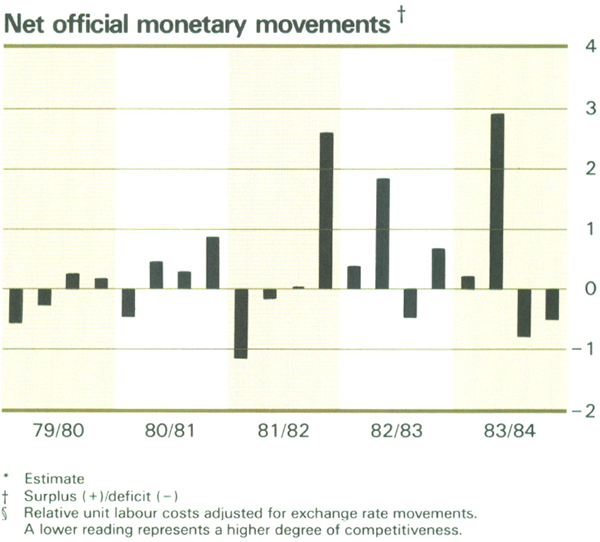
The value of exports increased by 15 per cent, the best result for several years. The impetus came evenly from non-rural and rural exports. Metal ores and minerals, mineral fuels and manufactured goods grew strongly in volume terms; however, price performance was subdued when account was taken of reductions in contract prices for coal and iron ore. Rural exports recovered from their slump although the pattern of increase differed from that of non-rural exports. There was a slight increase in volumes (which mainly reflected a substantial increase for cereals following improved seasonal conditions) but a large rise in prices, particularly for meat and sugar.
The value of imports increased by 9 per cent, strongly reversing the decline of over 3 per cent in the previous year. That decline had been due largely to lower import volumes; however, as cyclical influences in Australia asserted themselves and competitiveness weakened, import volumes picked up, particularly in the latter part of the year. Prices also rose but at a slower pace. Import demand was higher for most commodity groups except fuels, where new domestic production capacity pared import needs.
The strong export performance led to a significant turnaround in the trade account. The trade surplus of $231 million was the first since 1979/80. However, this improvement was not reflected in the current account outcome because of a marked increase in the deficit on invisibles. Heavy interest payments on the growing stock of overseas debt and cyclical factors – a higher level of investment income payable abroad and increased freight payments -were largely responsible. The current account deficit was slightly higher than last year but, with the economy growing strongly, the deficit fell as a ratio to GDP to about 3.6 per cent, compared with 3.8 per cent in 1982/83.
As in the two previous years, the current account deficit was more than covered by substantial net inflow of capital, the bulk on private account. The floating of the Australian dollar, however, meant a sharp break in this pattern. In the first half of 1983/84, private capital inflow of $5,745 million was almost double the current account deficit to that point. In the second half of the year, however, private capital inflow fell to $2,387 million, somewhat below the current account deficit. The greater part of private capital inflow in 1983/84 was in the form of borrowing; added to this were external borrowings by public non-monetary authorities and, to a lesser extent, the Commonwealth Government. As a result, Australia's gross external debt continued to rise strongly and by June 1984 had reached a ratio of about 40 per cent to GDP. This ratio has almost doubled over the past three years.
Australia's international reserves, including valuation effects, rose over the course of 1983/84 by $1,669 million to $12,417 million. A substantial build-up of reserves prior to the float was followed by a moderate rundown over the remainder of the year.
11 A Longer-term Perspective
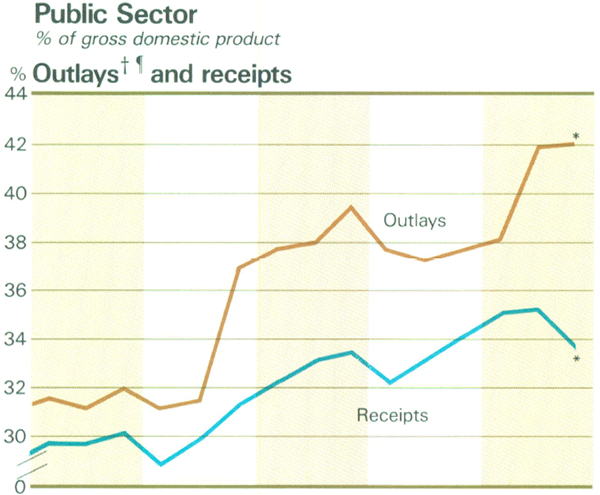
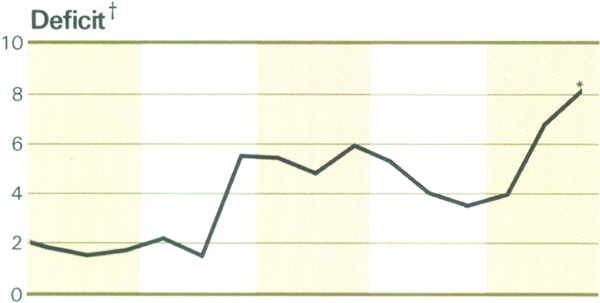
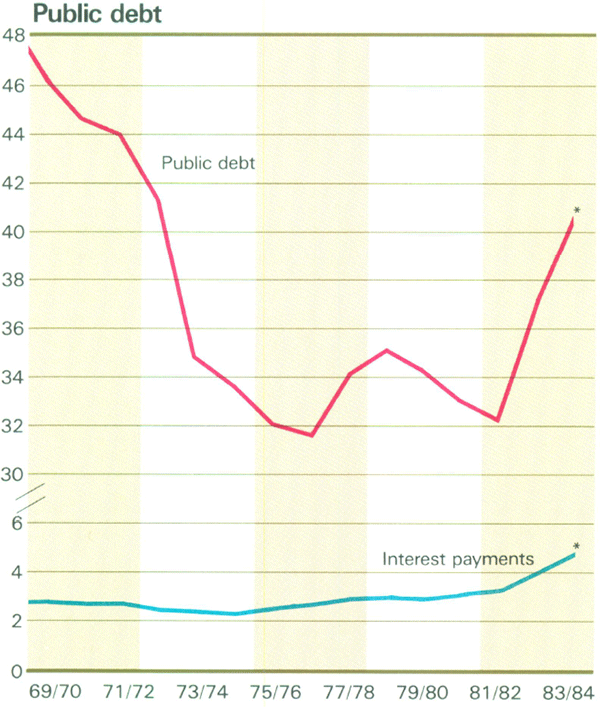
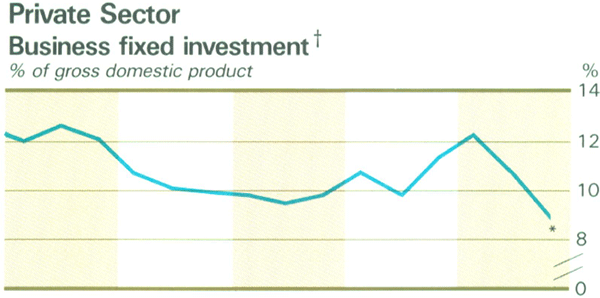
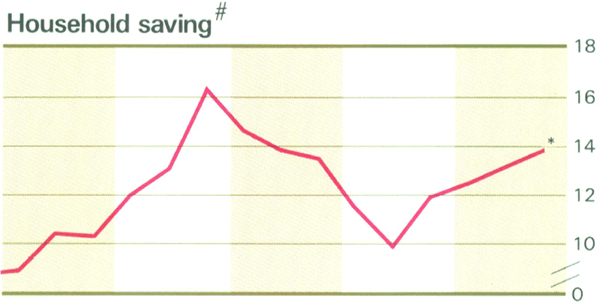
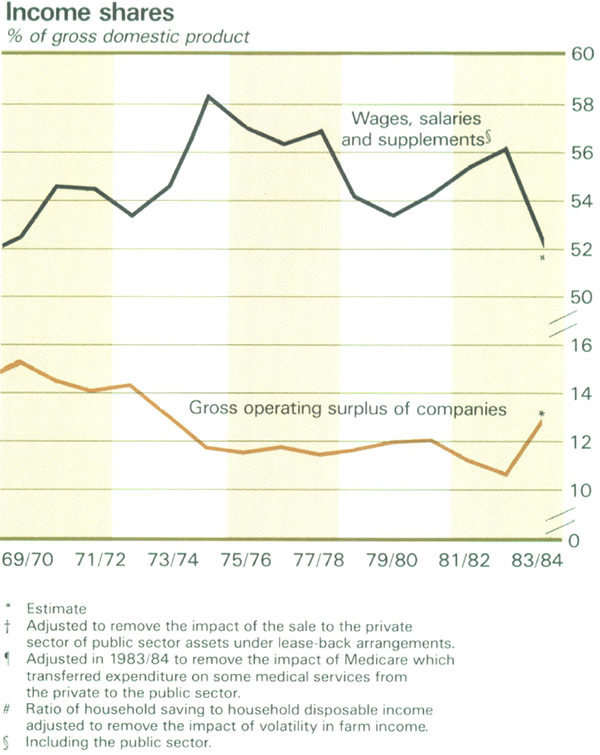
Footnote
Half-yearly reviews of economic and financial conditions in Australia appeared in the Bank's Bulletin in the July 1983 and February 1984 issues. A survey of international economic conditions appeared in the June 1984 issue. [*]